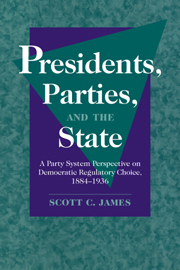 Presidents, Parties, and the State
Presidents, Parties, and the State Book contents
- Frontmatter
- Contents
- Acknowledgments
- 1 Introduction: Parties, Presidential Elections, and Regulatory Choice – A Party System Perspective
- 2 Swing States, Business Mugwumps, and the Interstate Commerce Act of 1887
- 3 The Progressive Party Vote and the Federal Trade Commission Act of 1914
- 4 Progressive Republicans and the “Death Sentence” for Public Utility Holding Companies During America's Second New Deal
- 5 Conclusion: Parties and the American Regulatory State
- Bibliography
- Index
5 - Conclusion: Parties and the American Regulatory State
Published online by Cambridge University Press: 06 January 2010
- Frontmatter
- Contents
- Acknowledgments
- 1 Introduction: Parties, Presidential Elections, and Regulatory Choice – A Party System Perspective
- 2 Swing States, Business Mugwumps, and the Interstate Commerce Act of 1887
- 3 The Progressive Party Vote and the Federal Trade Commission Act of 1914
- 4 Progressive Republicans and the “Death Sentence” for Public Utility Holding Companies During America's Second New Deal
- 5 Conclusion: Parties and the American Regulatory State
- Bibliography
- Index
Summary
The Party System Perspective and American Regulatory State Development, 1884–1936
The Democratic party was centrally involved in the construction of a modern American regulatory state. In this book, I have argued that the passage of the Interstate Commerce Act, the Federal Trade Commission Act, and the Public Utility Holding Company Act cannot be adequately explained through the use of conventional pressure-group frameworks or district-driven models of legislative choice. Rather, political party efforts to retain control of the presidency set the terms of Democratic decision making. In addition to this - and contrary to contemporary theories of legislative party organization - I have shown that party regulatory choices cannot be understood by reference to the median preference of the congressional Democratic caucus. Across the three historical periods I have examined, structures of party organization and levels of party discipline have substantially varied. But in each of the cases analyzed, party leaders emerge as central players in the definition of legislative choice. Whether railroad regulation, business regulation, or the “death sentence” for public utility holding companies, party policy choices did not emanate from the majority party's rank and file. Indeed, as we have seen, rank-and-file Democrats repeatedly fell in line behind choices that repudiated their own strongly held policy preferences. In order to understand the regulatory choices of Democrats in power we need to move beyond rank-and-file preferences to the preferences of party leaders. And we cannot understand the preferences of party leaders without factoring into the analysis the importance of the presidency as a much-desired party resource.
- Type
- Chapter
- Information
- Presidents, Parties, and the StateA Party System Perspective on Democratic Regulatory Choice, 1884–1936, pp. 267 - 282Publisher: Cambridge University PressPrint publication year: 2000
- 1
- Cited by
